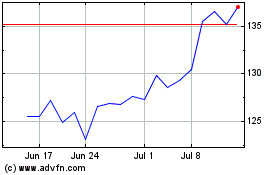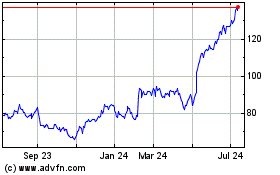Beware the PEG Ratio - Investment Ideas
August 26 2013 - 4:45PM
Zacks
The PEG ratio is a simple tool that can be useful in your search
for undervalued stocks. But it is far from a perfect metric and is
no substitute for doing your own homework.
Before we examine its shortcomings, let's first
explore what it is.
PEG Ratio Defined
The PEG ratio takes the basic price-to-earnings
ratio one step further by factoring in earnings growth. In short,
companies with faster earnings growth warrant higher P/E
ratios.
This metric was first popularized by Peter Lynch
and is calculated as:
Price/Earnings/Growth
According to Lynch, a company that's fairly priced
will have a P/E ratio equal to its growth rate. In other words, a
stock with a PEG ratio of 1.0 is fairly valued, while a stock with
a PEG ratio of less than 1.0 is undervalued and a stock with a PEG
ratio greater than 1.0 would be overvalued.
No Magic Bullet
While this seems intriguing and intuitive, remember
it is only a rule of thumb. The assertion that a P/E ratio
should equal earnings growth is somewhat arbitrary and certainly
does not apply to all companies.
Consider a blue chip company operating in a mature
industry. Its earnings growth may only be 5%. Does that mean it
should have a P/E ratio of 5? What if it pays a huge dividend? What
about a company with no growth... or even negative growth?
The intrinsic value of a business is the total of
all its free cash flow available to owners discounted to the
present value. This, of course, can be extremely difficult to
calculate with any accuracy. So the PEG ratio is simply a proxy for
it, and nothing more.
There is also no consensus on whether to use a
trailing or a forward P/E ratio and whether to use next year's
expected growth rate or a longer-term expected growth rate. But
this can have a major impact on the PEG ratio calculation.
Beware Those 5-year Growth Rates
I would argue for using a forward P/E since the
stock market is forward looking, along with a longer-term earnings
growth rate to keep a long-term perspective. However, use the
long-term earnings number only with a great deal of caution. That
is because the long-term earnings growth rates that analysts
publish are often way too optimistic.
A study by J. Randall Woolridge and Patrick Cusatis
of Penn State showed that analysts consistently project EPS growth
rates much higher than actual growth and that companies rarely meet
or exceed their projected EPS growth rates. In fact, over a period
of more than 20 years, Woolridge and Cusatis found that analysts'
long-term EPS growth forecasts averaged +14.7%, but companies
actual long-term EPS growth averaged only +9.1% - almost 40%
lower.
The study also found that analysts almost never
forecast negative long-term EPS growth, although it happens quite
frequently.
So do your own homework, and make sure those growth
rates seem reasonable. Because many bad investment decisions have
been made based on off-the-wall earnings growth projections.
3 Deceiving PEG Ratios
So what are some deceptively attractive PEG ratios
out there right now? Here are 3:
Apollo Group (APOL)
PEG Ratio: 0.6
5-Yr Projected EPS Growth: 10.5%
Apollo Group owns several for-profit educational
institutions including the University of Phoenix. A PEG ratio of
0.6 looks very attractive at first glance. However, if you look a
little closer, enrollment, revenue, profit margins and earnings
have all been moving in one direction for Apollo: down. In fact,
based on current consensus estimates, analysts project a 20%
decline in earnings for Apollo this year and a whopping 38% decline
next year. It seems very unlikely that the company can get to 10.5%
average EPS growth from there in just a couple of years.
Cirrus Logic (CRUS)
PEG Ratio: 0.6
5-Yr Projected EPS Growth: 16.9%
Cirrus Logic develops high-precision analog and
digital signal processing components for consumer entertainment
electronics, including smartphones. A high tech company with a PEG
ratio of 0.6 might sound alluring, but based on current consensus
estimates, analysts project a 32% drop in earnings this year and a
30% drop next year. The company would have to right the ship very
quickly to see anywhere near 16.9% average EPS growth over the next
5 years.
Vale (VALE)
PEG Ratio: 0.4
5-Yr Projected EPS Growth: 20.4%
Vale is a metals and mining company headquartered
in Brazil. A PEG ratio of 0.4 might be tempting, but investors will
probably be wise to ignore its siren call. Based on current
consensus estimates, analysts project a 5% drop in earnings for
2013 and a 12% drop in 2014. And those estimates have been
declining for several months. It's very unlikely that Vale can
compound its earnings at an average of more than 20% from here when
earnings are expected to decline this year and next.
The Bottom Line
The PEG ratio can be a useful rule of thumb for
finding undervalued securities. But it should only be a starting
place in that search. Don't blindly rely on those published 5-year
growth rates and do your own homework!
Todd Bunton is the Growth & Income Stock
Strategist for Zacks Investment Research and Editor of the Income
Plus Investor service.
Want More of Our Best Recommendations?
Zacks Executive VP, Steve Reitmeister, knows when
key trades are about to be triggered and which of our experts has
the hottest hand. Then each week he hand-selects the most
compelling trades and serves them up to you in a new program called
Zacks Confidential.
Learn More>>
APOLLO GROUP (APOL): Free Stock Analysis Report
CIRRUS LOGIC (CRUS): Free Stock Analysis Report
VALE SA (VALE): Free Stock Analysis Report
To read this article on Zacks.com click here.
Zacks Investment Research
Cirrus Logic (NASDAQ:CRUS)
Historical Stock Chart
From Jun 2024 to Jul 2024

Cirrus Logic (NASDAQ:CRUS)
Historical Stock Chart
From Jul 2023 to Jul 2024
